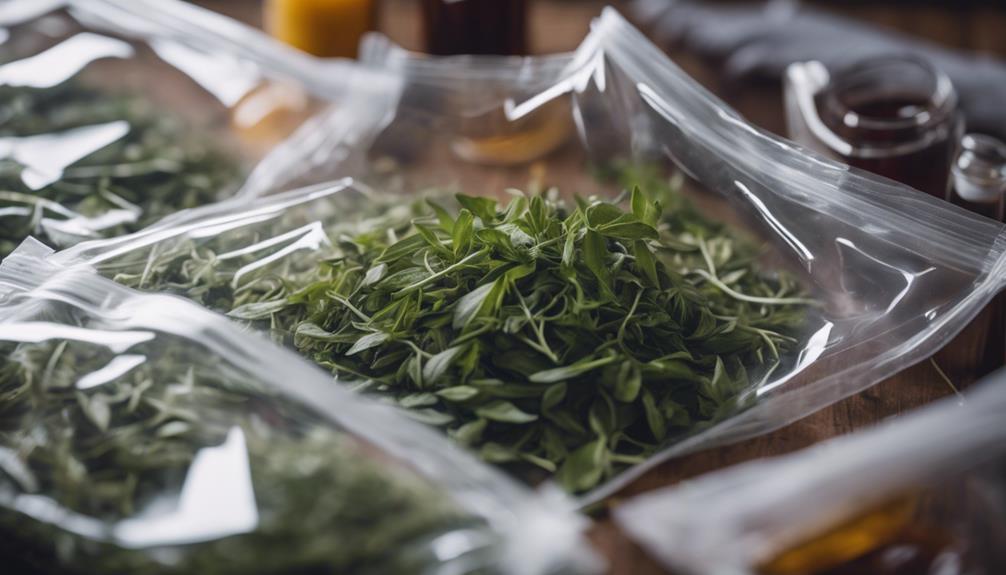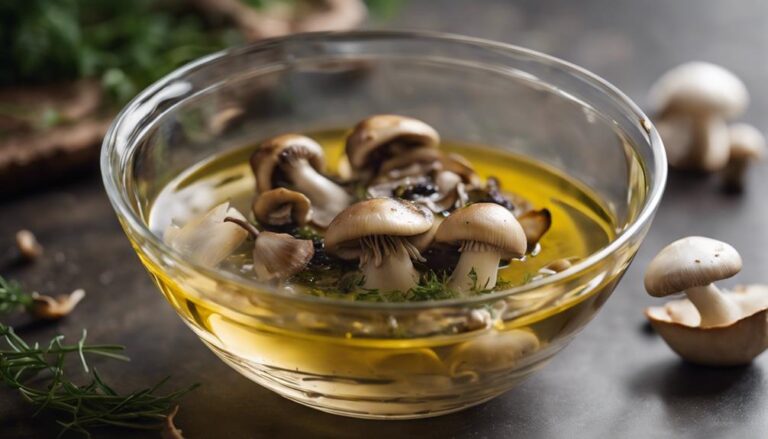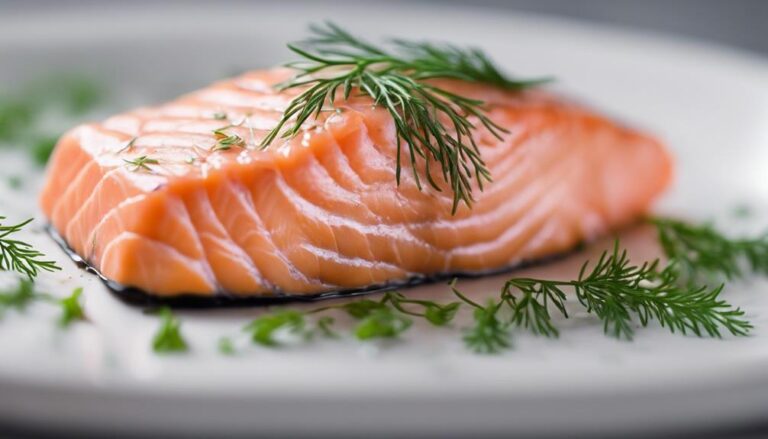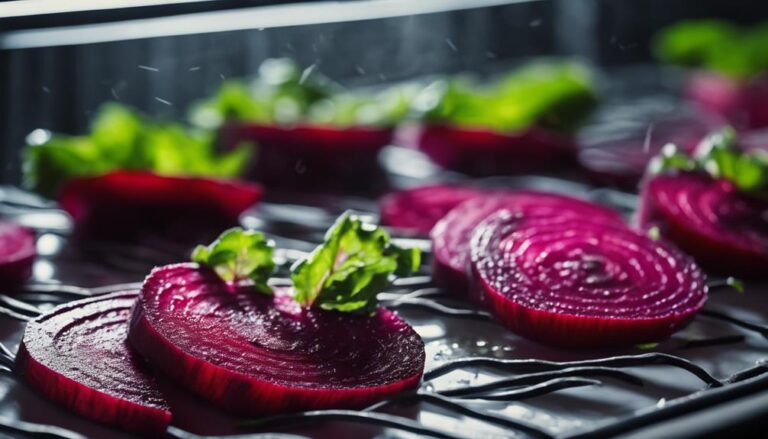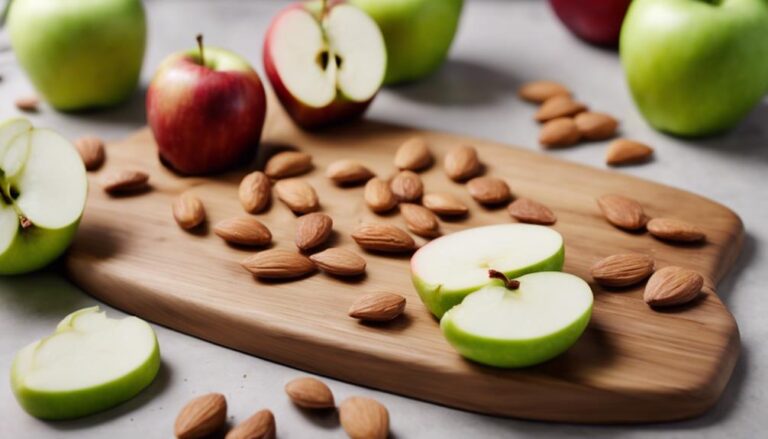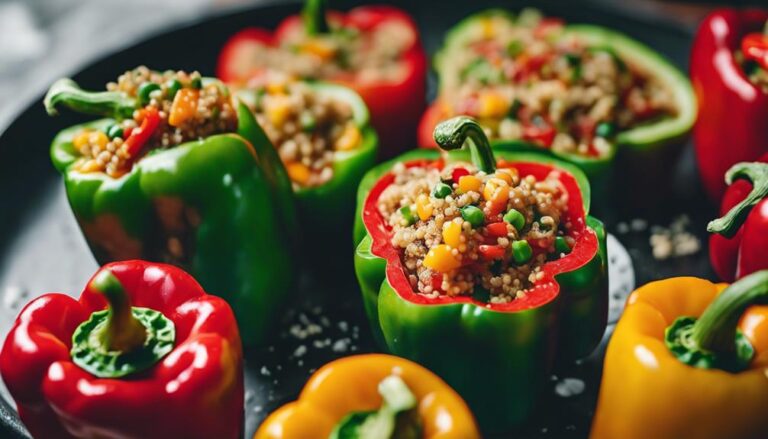Sous Vide Herbal Tea
Sous vide herbal tea offers a modern twist to traditional blends. To begin, gather fresh ginger root, lemon zest, water, and honey. Peel and slice the ginger, grate the lemon zest, then place everything in a sous vide bag and seal it. Next, set your sous vide machine to 185°F (85°C) and immerse the bag for an hour to infuse the flavors. Strain the tea, add honey to taste, and savor the delightful mix of ginger and lemon. Temperature control is key for the perfect brew. Explore further to enhance your herbal tea journey with unique blends and expert techniques.
What You Will Learn Here
- Set sous vide machine to 185°F for herbal tea infusion.
- Submerge sealed bag in water bath for 1 hour.
- Use fresh ginger root, lemon zest, water, and optional honey.
- Infuse flavors by vacuum-sealing ingredients in a sous vide bag.
- Strain infusion, add honey if desired, and enjoy the ginger and lemon blend.
Tea's Ancient Origins

Tea's ancient origins trace back to its historical roots in China, where it was first cultivated thousands of years ago.
Over time, tea has evolved from a medicinal herb to a beloved beverage with cultural significance around the world.
Understanding the evolution of tea provides insight into its rich history and global impact.
Tea's Historical Roots
Originally brewed over 5,000 years ago, herbal tea has a rich history that spans continents and cultures. Its historical significance is deeply rooted in traditional ceremonies across various civilizations. In ancient China, tea wasn't only a beverage but also a symbol of respect and gratitude. The Chinese tea ceremony, with its intricate rituals and etiquette, highlighted the cultural importance of tea in social interactions.
In India, tea played a significant role in Ayurvedic medicine and spiritual practices. The traditional Indian tea ceremonies often involved the use of herbs and spices believed to have healing properties, showcasing the holistic approach to health and wellness.
In Japan, the tea ceremony known as chanoyu emphasized harmony, respect, purity, and tranquility. Tea masters meticulously prepared matcha, a powdered green tea, in a ritualistic manner, creating a serene environment for contemplation and connection.
Throughout history, tea has transcended its role as a mere beverage to become a symbol of cultural heritage and social customs, embodying the essence of hospitality, friendship, and mindfulness.
Evolution of Tea
Herbal tea's journey through history traces back to its ancient origins, revealing a fascinating evolution that shaped the beverage we enjoy today. Tea's story begins in ancient China, where it was initially consumed for its medicinal properties. Over time, the cultivation and consumption of tea spread to other regions like Japan and India, leading to the development of different varieties and preparation methods.
The evolutionary trends of tea reflect changes in cultivation techniques, processing methods, and brewing practices. Innovations such as the invention of tea bags in the early 20th century revolutionized the way tea was consumed, making it more convenient for people around the world to enjoy a cup of their favorite blend.
Today, modern innovations continue to shape the tea industry, with advancements in packaging, flavor combinations, and brewing equipment catering to the diverse preferences of tea enthusiasts globally. From traditional loose-leaf teas to trendy herbal infusions, the evolution of tea showcases a rich history of adaptation and creativity that continues to thrive in the present day.
Cultural Significance of Tea
Having deep roots in ancient cultures, the consumption and rituals surrounding tea have played a significant role in shaping societal customs and traditions. Tea ceremonies, originating in China and later spreading to Japan and other parts of Asia, became a symbol of respect, tranquility, and hospitality. The global consumption of tea expanded as trade routes connected different regions, leading to the integration of tea into various cultural practices.
Tea's ancient origins date back to thousands of years ago, with legends attributing its discovery to the Chinese Emperor Shen Nong. Over time, tea evolved from a medicinal drink to a beverage enjoyed for its taste and social significance. The intricate tea ceremonies in countries like Japan highlight the meticulous preparation and presentation of tea, emphasizing harmony, respect, and mindfulness.
Through its journey across continents and centuries, tea has become more than just a flavorful drink—it serves as a bridge between traditions and modernity, connecting people through shared experiences and cultural heritage.
Tea Varieties
When exploring tea varieties, consider the unique flavors and aromas each type offers. Different types of tea come from distinct varieties of the Camellia Sinensis plant, each with its own processing method that influences taste and aroma.
Here are some popular tea varieties to explore:
- Green Tea: Known for its fresh and grassy flavor, green tea is rich in antioxidants and is often associated with various health benefits such as improved brain function and fat loss.
- Black Tea: With a bold and robust flavor, black tea is fully oxidized, giving it a darker color and stronger taste. It's commonly enjoyed with milk or sugar and is known to support heart health.
- Oolong Tea: Oolong tea falls between green and black tea with regard to oxidation levels, offering a diverse range of flavors from floral to fruity. It's believed to aid in weight management and promote healthy skin.
- White Tea: The least processed of all teas, white tea has a delicate flavor profile with subtle sweetness. It's valued for its high antioxidant content and potential cancer-fighting properties.
Herbal Tea Infusions
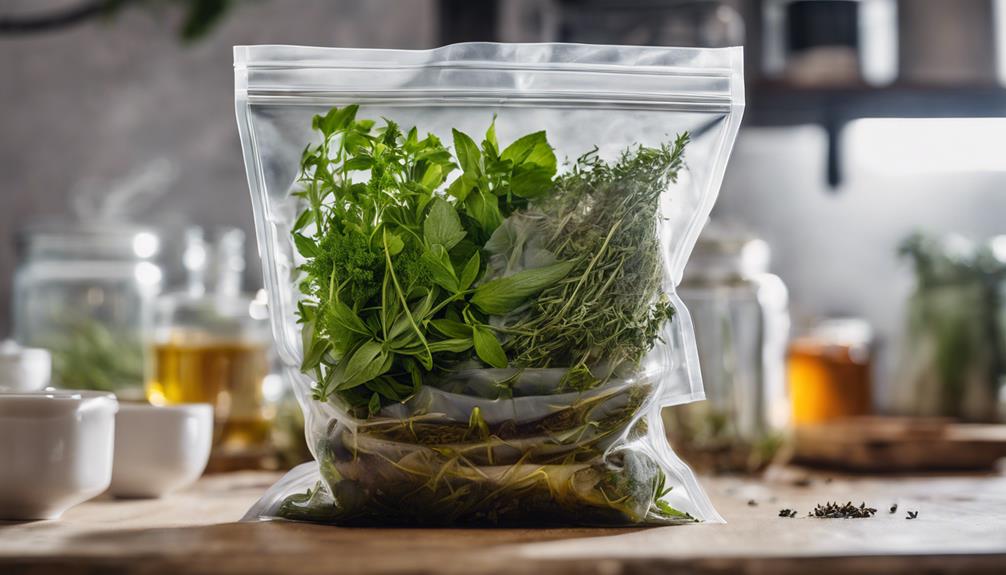
When it comes to herbal tea infusions, you have a variety of options to explore.
Try the invigorating Minty Lavender Infusion for a soothing blend of flavors.
If you're looking to unwind, the Chamomile Relaxation Blend might be just what you need.
For a zesty twist, consider the revitalizing Ginger-Lemon Zest Infusion.
Minty Lavender Infusion
Infuse your sous vide herbal tea with an invigorating blend of mint and lavender for a delightful and aromatic beverage experience. The combination of minty flavors and the calming benefits of lavender creates a harmonious infusion that's both invigorating and soothing.
Here are some steps to achieve the perfect Minty Lavender Infusion:
- Select Quality Ingredients: Choose fresh mint leaves and dried lavender buds for the best flavors and aromas.
- Proper Infusion Techniques: Place the mint leaves and lavender buds in a sous vide bag, ensuring they're evenly distributed for consistent flavor infusion.
- Aroma Balance: Adjust the amount of mint and lavender to achieve the desired balance of flavors. Mint can be overpowering, so use it sparingly to complement the lavender.
- Time and Temperature: Sous vide the herbal tea infusion at a temperature of 175°F (79°C) for 20 minutes to allow the flavors to meld together perfectly.
Enjoy the Minty Lavender Infusion for a relaxing and fragrant tea experience.
Chamomile Relaxation Blend
Explore the soothing qualities of chamomile in your herbal tea infusions with a Chamomile Relaxation Blend. Chamomile is renowned for its stress relief and sleep aid properties, making it an excellent choice for winding down after a long day.
Here are some key points to contemplate when brewing your Chamomile Relaxation Blend:
- Stress Relief: Chamomile is known for its calming effects on the mind and body. By incorporating it into your herbal tea infusion, you can create a moment of tranquility to help alleviate stress and anxiety.
- Sleep Aid: The gentle aroma and flavor of chamomile can promote relaxation and improved sleep quality. Sipping on a cup of Chamomile Relaxation Blend before bedtime may help you unwind and prepare for a restful night's sleep.
- Flavor Profile: Chamomile offers a mild, slightly floral taste that pairs well with other herbs like lavender or mint for added depth of flavor.
- Brewing Instructions: To maximize the benefits of chamomile, steep your Chamomile Relaxation Blend in hot water for 5-7 minutes before enjoying its soothing properties.
Ginger-Lemon Zest Infusion
For an exhilarating twist to your herbal tea experience, consider infusing a zesty blend of ginger and lemon. This Ginger-Lemon Zest Infusion will awaken your senses with a citrus twist and a spicy kick. Here's how to create this delightful herbal tea infusion:
- Ingredients:
- Fresh ginger root
- Lemon zest
- Water
- Honey (optional)
- Preparation:
- Peel and slice the ginger root.
- Grate the lemon zest.
- Place the ginger slices and lemon zest in a sous vide bag.
- Add water to the bag and vacuum-seal it.
- Sous Vide Process:
- Set your sous vide machine to 185°F (85°C).
- Submerge the sealed bag in the water bath for 1 hour to infuse the flavors.
- Serving:
- Strain the infusion into a cup.
- Add honey for sweetness if desired.
- Enjoy the invigorating blend of ginger and lemon with its exhilarating citrus twist and spicy kick.
Herbal Tea Brewing Techniques
When brewing herbal tea, pay attention to the brewing time variations, as different herbs require varying lengths of infusion to achieve best flavors.
Remember that controlling the temperature during brewing is essential to extract the desired essences without risking bitterness or losing delicate aromas.
Experiment with different flavor infusion methods, such as cold brewing or using natural sweeteners, to create unique and invigorating herbal tea blends.
Brewing Time Variations
To achieve peak flavor extraction, adjust the brewing time based on the specific herbal tea blend you're using. Each herbal tea variety has unique characteristics that require different brewing times to bring out the best taste. Consider the brewing temperature and flavor profiles of the herbal tea when determining the ideal steeping time for maximum flavor extraction.
For herbal teas with delicate flavors and aromatic notes, a shorter steeping time is recommended to prevent the brew from becoming overly bitter or overpowering. Lighter herbal teas such as chamomile or lemongrass generally require around 3-5 minutes of steeping to maintain their subtle flavors. On the other hand, robust herbal blends like peppermint or ginger may benefit from a longer steeping time of 5-7 minutes to fully release their bold flavors and soothing aromatic notes.
Adjusting the brewing time based on the specific herbal tea blend guarantees that you experience a well-balanced and flavorful cup every time.
Temperature Control Importance
Maintaining precise temperature control is essential in mastering the art of brewing herbal tea to fully maximize its flavor potential. When it comes to herbal tea, temperature precision plays a vital role in extracting the desired flavors from the herbs. Using sous vide benefits the tea infusion process by ensuring a consistent temperature throughout, allowing for a more controlled extraction of flavors.
Sous vide provides a stable environment that prevents the tea from overheating or cooling down too quickly, which can negatively impact the flavor extraction. The gentle and even heat distribution of sous vide enhances the infusion process, allowing the herbs to release their flavors gradually without the risk of burning or becoming bitter. This method is especially useful for delicate herbal blends that require a precise temperature range for excellent flavor extraction.
Flavor Infusion Methods
For ideal flavor infusion in herbal tea brewing techniques, focus on utilizing methods that enhance the gradual release of herb flavors without risking bitterness or burning, especially with delicate blends.
To achieve this, consider incorporating fruit infusion to add a natural sweetness and depth to your herbal tea. Fruits like berries, citrus, or even tropical fruits can complement the herbal notes and create a more complex flavor profile.
Another effective way to infuse your herbal tea with rich flavors is by using a spice blend. Experiment with spices like cinnamon, ginger, cloves, or cardamom to elevate the taste of your brew. These spices not only add warmth and complexity but also help balance out the herbal elements, creating a well-rounded and satisfying cup of tea.
Final Thoughts
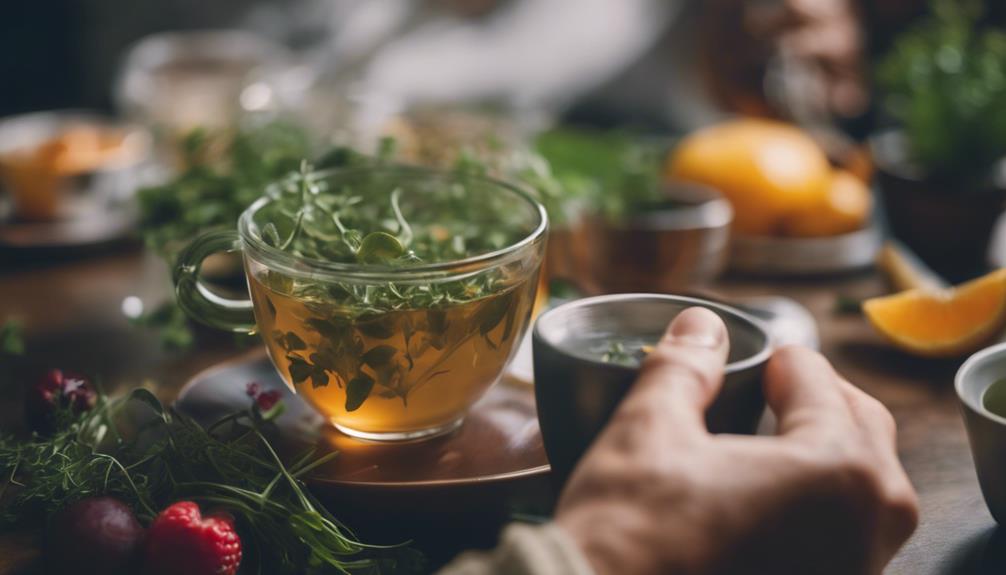
Considering all the flavors and aromas that can be infused into your sous vide herbal tea, the final product is a delightful and versatile beverage suitable for any occasion. The health benefits of herbal teas are numerous, with different blends offering various advantages such as aiding digestion, boosting immunity, or promoting relaxation. By using sous vide, you can retain more of the herbs' natural goodness compared to traditional brewing methods, ensuring you get the most out of your tea.
Moreover, the aromatherapy benefits of herbal teas can contribute to relaxation techniques. The gentle scents released during the sous vide process can help create a calming atmosphere, perfect for unwinding after a long day or preparing for a restful night's sleep. Experimenting with different herbs and blends can also add an element of mindfulness to your tea-drinking routine, allowing you to fully immerse yourself in the experience and savor the moment.
Frequently Asked Questions
Can Sous Vide Herbal Tea Be Stored for Later Consumption?
When storing sous vide herbal tea for later consumption, guarantee long term preservation by refrigerating promptly. Reheat for convenience. Properly stored tea can maintain its flavor and quality. Enjoy a invigorating cup whenever you desire.
Are There Any Specific Health Benefits Associated With Sous Vide Herbal Tea?
When considering nutritional benefits and specific brewing techniques, sous vide herbal tea offers a unique way to extract flavors and nutrients efficiently. Experimenting with different herbs can provide various health benefits depending on your choices.
How Does the Sous Vide Method Affect the Flavor of Herbal Tea?
When you use the sous vide method, you can expect flavor enhancement due to precise temperature control. The technique boosts infusion efficiency, leading to rich, aromatic tea. This method also aids in aroma retention, ensuring a delightful tea experience.
Can Different Types of Sweeteners Be Used in Sous Vide Herbal Tea?
You can experiment with various sweetener variations in sous vide herbal tea to discover new flavor profiles. Try honey, agave, or stevia for different tastes. Adjust amounts to find the perfect balance that suits your preferences.
What Are Some Creative Ways to Incorporate Sous Vide Herbal Tea Into Recipes?
Get creative with sous vide herbal tea! Infuse desserts for a unique twist or elevate your cocktail mixology game. Experiment with different flavors and combinations to add a sophisticated touch to your culinary creations.
Conclusion
To sum up, delving into the world of herbal tea through sous vide cooking can enhance your tea experience to new heights. By infusing flavors and aromas in a precise and controlled manner, you can create unique and personalized blends that cater to your taste preferences.
With a variety of tea options and brewing techniques to choose from, the possibilities are endless. So, grab your favorite herbs, experiment with different combinations, and enjoy the soothing benefits of a perfectly brewed cup of herbal tea.
